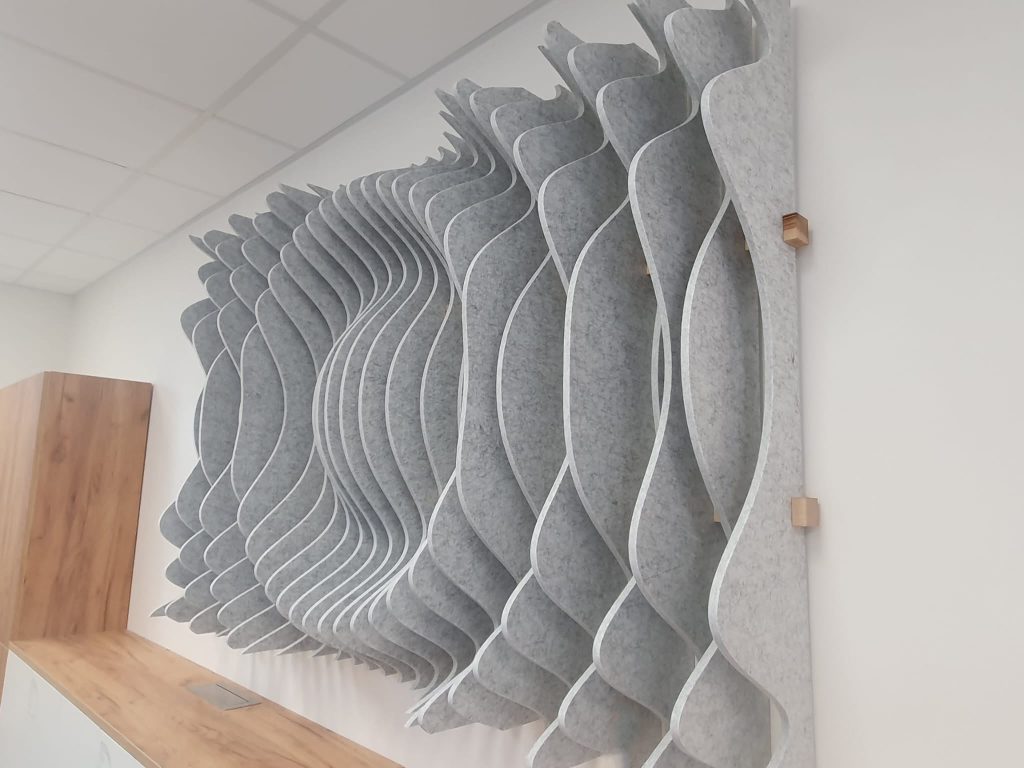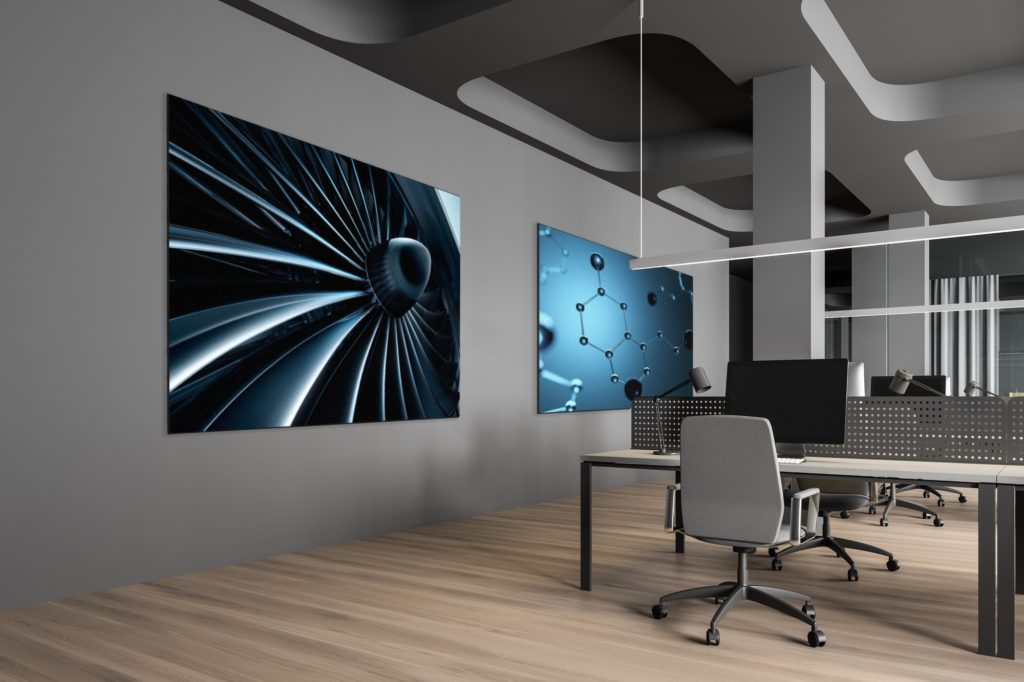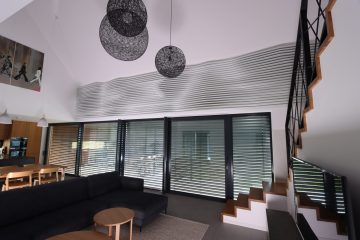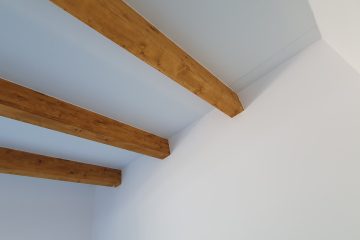We are often not even aware of the presence of sound (noise). However, its influence is essential for our inner well-being and performance. Sound can absorb, relax and satisfy us (music), but it can also upset us. Unlike our eyes, our ears perceive even in sleep. This physiological fact only confirms the importance of sound perception in human life.
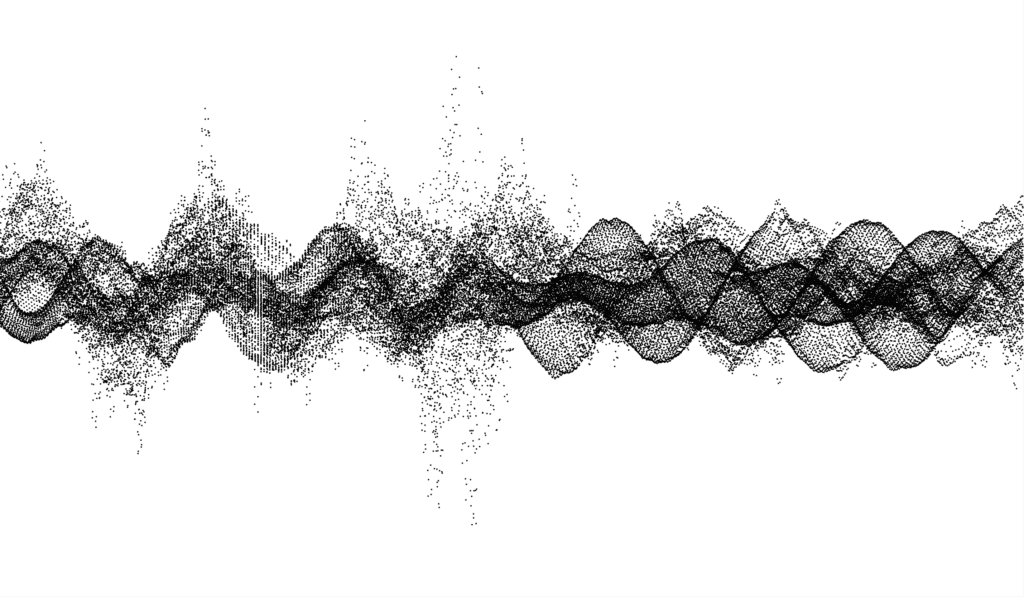
The following article attempts to briefly describe hearing perception, what noise is and its direct effect on health. An introduction to acoustics summarizes the behavior of sound and its intelligibility in spaces of various sizes, from arenas to classrooms and offices. We also provide an overview of the hygienic requirements for noise according to the standards and how we define intelligibility in acoustics. Practice what and where helps most with echo reduction.
Hearing as a sense and perception of sound
For humans, sound is the most important communication tool. The color of the voice helps us identify a familiar person even if we cannot see them. With the spoken word, we can express ideas and gain attention much more effectively than with written text. With the help of voice intonations, we put emotions into the speech. One of Darwin’s hypotheses states that music and speech come from the same emotional system as nature. Sound therefore significantly affects how a person feels. One of the vital functions of hearing is the ability to analyze stimuli that warn of impending danger.

An unexpected sound triggers a process in the body in which cortisol is released into the blood, which increases blood pressure and results in a change in breathing. This reflex is the result of tens of thousands of years of human development. At every unexpected sound, we instinctively expect danger and our body is ready to defend itself.
Noise and its effect on human health
While music brings us positive mood and emotions, noise (English “noise” is derived from the Latin word “nausea” – means nausea). Music is proven to relieve stress, just as excessive noise is proven to create stress. Noise has a major impact on health, causing hypertension (high blood pressure), increased risk of heart attacks, reduced immunity, chronic fatigue and insomnia. Research has shown that the incidence of civilization diseases directly increases with the noise level of the given environment. Hearing problems in humans are among the ever-increasing diseases. Noise abnormally irritates the cerebral cortex and stimulates the central nervous system. It thus affects a person’s overall health, well-being and cognitive development. In terms of time, we distinguish short-term (acute) and long-term (chronic) effects of noise. This includes the effect of noise in school classrooms on the teacher’s vocal cords. Inappropriate classroom acoustics force the teacher to constantly raise his voice, trying to shout over his own echo. Which can lead to problems with the vocal cords and their permanent damage.
The Lombard phenomenon
When we have fun in a restaurant where there are a lot of people, the noise gradually increases and we are forced to have fun more and more loudly. This is a subconscious raising of the voice due to loud background noise. This phenomenon is often accompanied by other changes in speech, increasing the fundamental frequency, equalizing the frequency spectrum and lengthening the signal. We categorize speech, which includes all these changes, as the so-called Lombard phenomenon.

Sound propagation in indoor spaces
The ancient Greeks and Romans were already involved in the propagation of sound. How to build a quality theater, church or space for music has gradually developed throughout history. J. W. Goethe: “Architecture is petrified music.” Until the middle of the 20th century theaters and concert halls were designed based on good or bad experience with already existing problems. The definition of reverberation time by the physicist W. C. Sabin in 1922 became the impetus for the development of a new scientific field called spatial acoustics. The basis for characterizing the interior space from the point of view of spatial acoustics is the so-called impulse response or reflectogram.

Reflectogram
When we clap loudly in a closed room, a sound wave will spread through the room and bounce off the walls and obstacles. If we were to record the successively arriving sound reflections at the listener’s location in a graph, we would create a so-called reflectogram. From a mathematical point of view, it is a histogram of the distribution of sound energy over time.
Assessment of speech intelligibility
From an acoustic point of view, human speech consists of vowels and consonants. Vowels have more acoustic energy, consonants provide more information. Consonants usually occur at frequencies greater than 1 kHz, vowels are at lower frequencies. The number and structure of vowels and consonants varies in different languages. Languages where vowels predominate feel louder. It is therefore physically obvious that consonants are more easily masked by noise than vowels. With a long reverberation, the sound energy of the vowels will linger longer and mask the consonants. We will hear the speaker’s voice, but we will not understand him.
Acoustics and intelligibility of speech or music
Speech intelligibility can be objectively measured and calculated in several ways. In Europe, the STI – speech transmission index (Speech Transmission Index) and its variants RASTI, STIPA are most often used. In North America, the USA and Canada, an older parameter called AI articulation index is still used, which is based only on the useful signal-to-noise ratio and does not take reverberation into account. From the impulse response we can also derive other quantities related to the intelligibility of speech. According to the ratio of the first and last sound reflections, we can define clarity D50 and clarity C50 or C80. These parameters are based on the fact that reflections within the first fifty ms effectively amplify the direct sound.

Effect of room volume and shape on acoustics
Human speech with a reverberation time of 5 – 6 s in a classroom or school classroom with a volume of approx. 300 m3 already at a distance of 2 m between the listener and the speaker, the voice will be very unintelligible. The speaker will tend to amplify the voice see Lombard phenomenon above. The same reverberation time of 5 – 6 s in the St. Vitus Cathedral in Prague with a volume of approx. 30,000 m3 and a distance of 2 m from the speaker will give very good intelligibility. When we have two rooms with the same reverberation time and a hundred times different volume, in order to achieve the same speech intelligibility, we need to increase sound absorption 4.7 times in the smaller room. In a large space, the density of the first reflections, which have the greatest influence on the sound power, is much lower than in a small room.
Acoustics of spaces for sports
In sports halls and gymnasiums, the main problem is the noise produced inside by the noise of footsteps, the impact of balls or the cheering of spectators in the audience. From a construction point of view, the volume and shape of the space, the layout and the amount of sound-absorbing materials play a big role in terms of acoustics. In gymnasiums there is a so-called fluttering echo caused by insufficient diffusion. With the typical dimensions of a block-shaped gymnasium, we would calculate that if the entire ceiling is sound-absorbing, everything will be fine. However, we know from practice that if we apply absorption only to the suspended ceiling, we reduce the reverberation time by approximately 30%. At least a quarter of all internal surfaces should be sound-absorbing, and their placement depends on the shape of the given space. When only one wall or two opposite walls are acoustically resolved, we solve problems with the so-called flickering echo. When designing, we must always think in 3D space and apply acoustically absorbing materials to all walls and the ceiling.
Large sports halls, arenas
Arenas are not only used for sports, but perform a multi-purpose function for concerts, conferences, festivals, exhibitions and fairs. From the point of view of qualification and quantification of the acoustic solution, it is advisable to reduce the total reverberation time at least on the ceiling.
Classrooms, meeting rooms, auditoriums
Information conveyed by the voice, its color and intonation are best remembered. Therefore, quality acoustic conditions are the basis of the education process. A very common problem in the classrooms of primary, vocational, secondary and university schools is precisely the reduced intelligibility of speech and demonstrably faster fatigue caused by poor intelligibility of the spoken word and a long reverberation time (echo). Children prone to dyslexia suffer greatly in classrooms with poor acoustics. In classrooms with poor acoustics, the intelligibility of the teacher’s speech is much better in the first desks than in the last. There is one common denominator when designing the acoustics of classrooms, auditoriums and meeting rooms, and that is the reverberation time. The smaller the better.
Sound intensity and acoustic performance
Acoustic intensity characterizes the amount and direction of acoustic energy. It is expressed as acoustic power per unit area.
| Acoustic pressure [dB] | Acoustic pressure [Pa] | Sound intensity [W/m2] | Sound source |
| 0 | 0,00002 | 0,000000000001 | threshold of audibility |
| 10 | 0,000063 | 0,00000000001 | the rustle of leaves on the trees in a very light breeze |
| 20 | 0,0002 | 0,0000000001 | noise in the apartment at night, nature, no wind |
| 30 | 0,00063 | 0,000000001 | a low whisper |
| 40 | 0,002 | 0,00000001 | rustle of leaves, common noise background |
| 50 | 0,0063 | 0,0000001 | background noise in the apartment during the day |
| 60 | 0,02 | 0,000001 | ordinary conversation |
| 70 | 0,063 | 0,00001 | lecture speech, applause in the hall |
| 80 | 0,2 | 0,0001 | vacuum cleaner, truck |
| 90 | 0,63 | 0,001 | scream, passing train |
| 100 | 2 | 0,01 | chainsaw |
| 105 | 3,555 | 0,317 | car on the highway |
| 110 | 6,311 | 0,1 | noisy metal concert |
| 115 | 11,24 | 0,317 | jackhammer work |
| 120 | 20 | 1 | the start of a plane 300m away |
| 130 | 63 | 10 | noise when forging iron |
| 140 | 200 | 100 | pain threshold |
| 150 | 630 | 1000 | turboprop plane 10m |
Hygienic requirements for noise in the indoor environment
Noise and vibration are by their nature harmful to the human organism in any space, position and time. The determining variables are evaluated: noise, infrasound or vibration. Reference time interval to which the permissible value applies:
- Dayinterval from 6:00 to 18:00 (total 12 hours)
- Evening interval from 18:00 to 22:00 (total 4 hours)
- Night interval from 22:00 to 6:00 (total 8 hours)
From STN730532
| Space description | Time | Noise from inside resources [dB] | Noise from outside resources [dB] | |
| A | Hospital rooms, spa accommodation | day evening night | 35 30 25 | 35 30 25 |
| B | Living rooms, hostels, retirement homes, nurseries, crèches | day evening night | 40 40 30 | 40 40 30 |
| C | Classrooms, auditoriums, reading rooms, study rooms, conference rooms, courtrooms | at the time of use | 40 | 40 |
| D | Rooms for public relations, information centers | at the time of use | 45 | 45 |
| E | Spaces requiring speech understanding, e.g. school workshops, lobbies and waiting rooms | at the time of use | 50 | 50 |
Acoustics and speech intelligibility
STI (Speech Transmission Index) or intelligibility index is an objective unit of sound quality.
Subjective perception of sound intelligibility according to STI
| Excellent | >0,75 |
| Good | 0,60 až 0,75 |
| Sufficient | 0,45 až 0,60 |
| Inadequate | 0,30 až 0,45 |
| Bad | <0,30 |
Excellent intelligibility given the price of the acoustic solution is not a common goal in room acoustics. In large and relatively noisy places, achieving sufficient intelligibility is a realistic goal.
The STI parameter has a wide range of uses. It is mainly used in spatial acoustics to evaluate the intelligibility of halls, churches or conference rooms. Another use of STI is to determine the quality of transmission for TV, radio, telephones, radio and the like.
Acoustics in practice
The main influence determining the acoustic quality of the space is the reverberation time (echo). The NRC coefficient defines the reflectivity of different surfaces. Hard materials such as glass, concrete, wood reflect acoustic energy, and soft materials such as carpets, thick curtains, upholstered furniture absorb acoustic energy.
The proportion of hard (acoustically reflective) and soft (acoustically absorbing) materials inside the space determines its acoustic behavior.
Standard ČSN 73 0526 divides spaces according to their purpose and size, standard ČSN 73 0527 recommends an ideal reverberation time for these spaces.
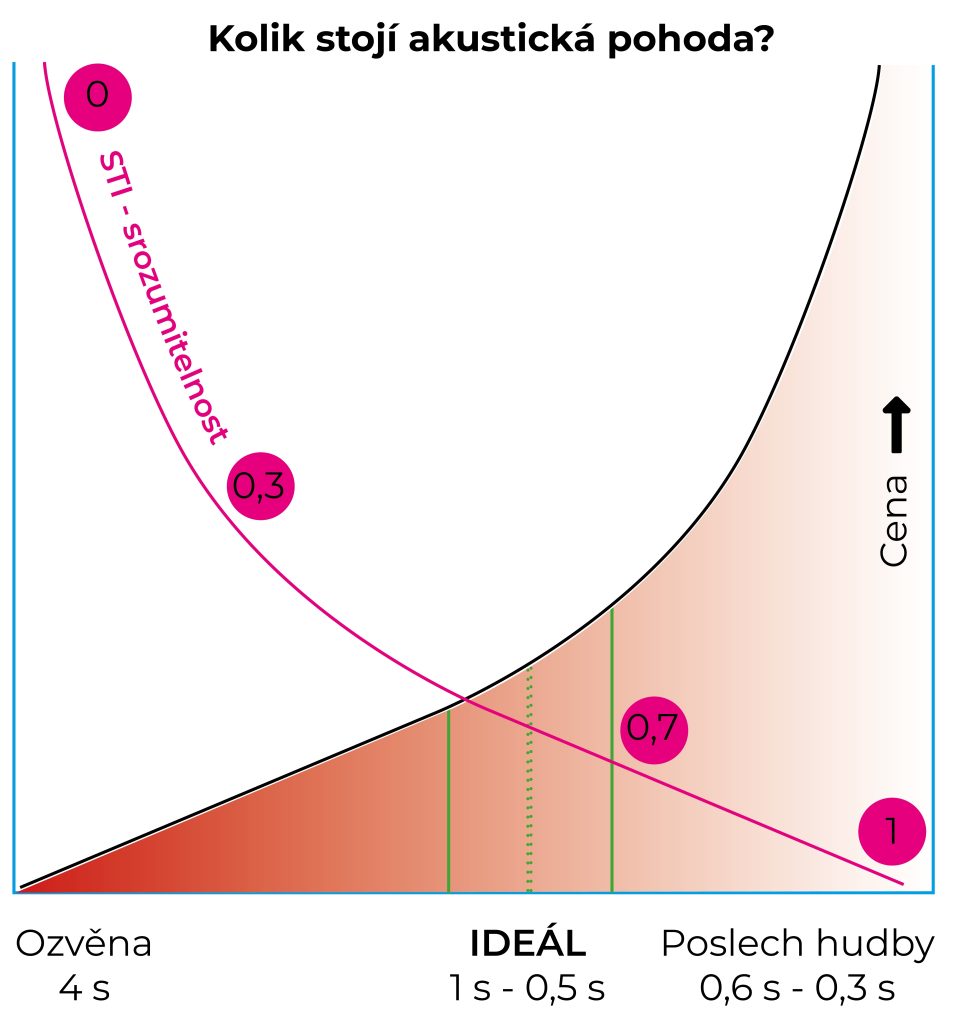
Tips to reduce reverberation
Add acoustically absorbing materials to the space. Where carpets and curtains cannot be used for hygienic or practical reasons, modern acoustic panels such as Silentmax® can be used. Acoustic panels absorb acoustic energy wherever they are in contact with air.
The perception of acoustics has an effect on the psyche. A large echo characterizes stress, discomfort, poor intelligibility. Your customer or client or student will remember these properties. Consciously or subconsciously, they then associate discomfort with your office, restaurant, or meeting room.
The effectiveness of acoustic panels is highest if we place them opposite the most sound-reflective surfaces, i.e. opposite windows. It does not matter at all if this request cannot be met. Acoustic panels absorb slightly less, but still very effectively wherever they are in contact with the surrounding air. A sound wave is reflected fifty to a hundred times in space. Although the acoustic panel does not capture the first direct acoustic wave, it absorbs the reflections very effectively.
The even distribution of acoustic panels has an effect on speech intelligibility, STI. The more evenly we place the acoustic panels, the more intelligible the sound will be. However, it is still true that the fundamental parameter is the reverberation time, uniformity is secondary.
The amount depends on the rhetorical question “how much do you want to reduce the echo?”. It is true here that with a large echo, relatively little acoustic material will do a great job and the subjective perception of the echo in the room will improve a lot. “little” is 5% of the total surface of the space (walls+ceiling+floor).
Types of premises according to their purpose
Acoustic comfort is often neglected today. However, it has a fundamental effect on the psyche and feelings that your customer will take away. Acoustically designed spaces feel pleasant and people like to return to them.
Restaurant: if we simply stick Silentmax® under the tables, chairs, benches, we increase the acoustically absorbing surface and thereby reduce the reverberation. Even if the acoustic panels are not spread evenly, they will still work and reduce the overall echo. Furthermore, the acoustic panels can be cut in any way, for example they can be applied under the ceiling or suspended in the space. We can print the acoustic panel in any way. It can thus complement the lines of the interior or underline its atmosphere (landscape, detail of coffee beans, hops, etc.).
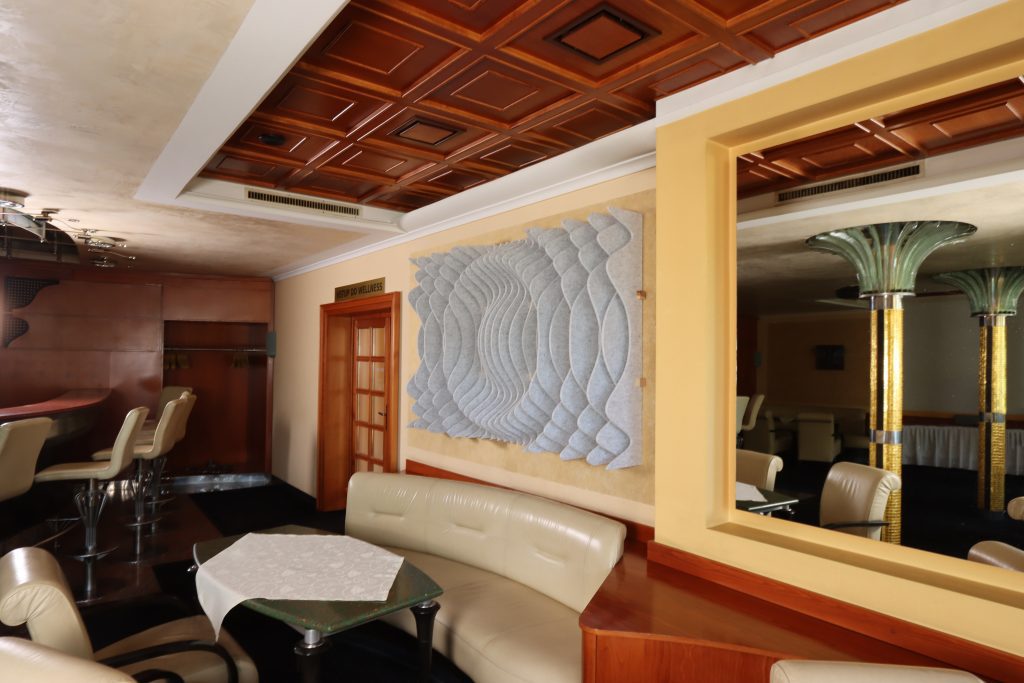
Gymnasiums: Silentmax® acoustic panels are mechanically very resistant. they can be simply hung from the ceiling, or glued or screwed to the walls. Kicking a ball or hitting a 100kg fighter certainly doesn’t matter.
Classrooms: By reducing the reverberation, you fundamentally improve the acoustic parameters of the space. The teacher will not tend to shout over himself and his speech will be clearer. Acoustic panels can be applied in any way so that they do not disturb the visuals of the existing classroom, as for example here. We can print Silentmax®, creating an acoustically absorbing wall.
Offices, meeting rooms: Complete the visual with a modern Silentmax3D acoustic panel or an acoustic image that we print for you with a logo or some detail from your field. The ideal location of the acoustic image is opposite the window, but it is not a condition.
